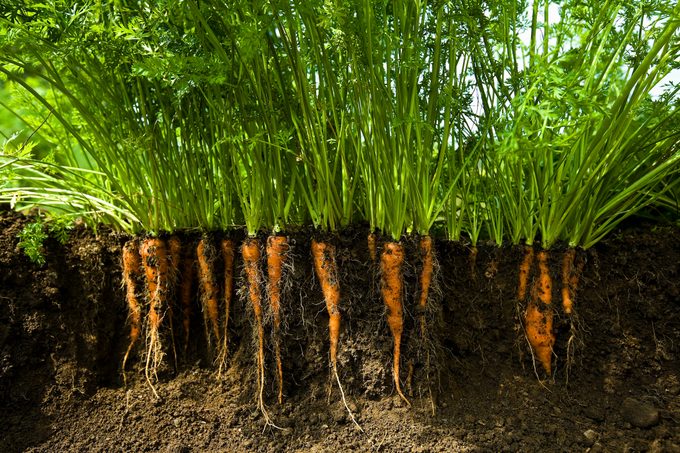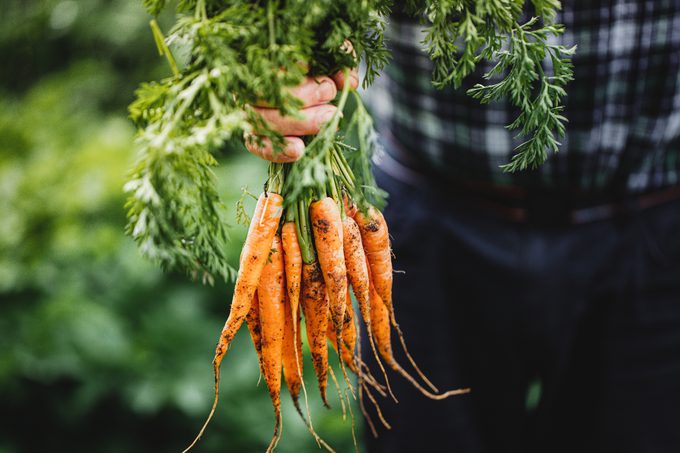
Although carrots are not the easiest vegetable to grow, they’re a sweet and earthy addition to your home-grown repertoire. Whether you like your carrots roasted or as a crudité, read on to learn about the various types and how to grow carrots.
Types of Carrots To Grow
Choose a kind based on your garden soil and culinary preferences.
- Imperator carrots can grow up to ten inches long. They’re the best for eating fresh, but you need deep, loose soil to grow them.
- Chantenay carrots are short, stubby and cone-shaped. They’re a good choice if you lack deep, loose soil. They’re best for cooking, though must be picked small before their core becomes woody and inedible.
- Danvers carrots are classic tapered orange carrots. They have long roots but can handle shallower soil than the imperator types above.
- Kaleidoscope Blend lets you grow a rainbow of carrots — red, purple, white, orange and yellow.
- Nantes carrots are orange with a uniform, slightly tapered shape, ending in a blunted tip. People love them for their sweet flavor.
How To Plant Carrots
Start carrots from seed, both outside and inside.
Carrots grow best in cool weather. Plant seeds outdoors in early spring, at least three weeks before your last frost date, as determined by your USDA Plant Hardiness Zone. In my Zone 7 garden, I sow seeds the second week of March. I have even better harvests when I plant carrots in the fall in cold frames, basically small in-ground greenhouses.
I start seeds under lights indoors and transplant the seedlings, or sow seeds directly into the cold frame’s soil. As the weather cools, I close the cold frame’s transparent top and water the carrots every couple of weeks. They don’t need as much water in cooler weather. The carrots will grow until mid-winter when the days become too short. Then they hold over throughout winter and begin growing again as days lengthen. They end up being sweeter, too.
Because carrots need loose, fertile soil, raised beds or containers are ideal.
- Choose a spot that gets full sun, at least six to eight hours. If you want to grow imperator carrots, choose soil at least eight to ten inches deep.
- Work plenty of compost into the soil and remove rocks, which can distort the carrots as they grow.
- Also work a good organic, granular fertilizer into the soil, at the rate listed on the package.
- Sow seeds 1/4-in. deep and cover them with loose soil.
- Pat the soil into place and water with a hose-end sprayer.
How Long Do Carrots Take To Grow?
Depending upon the variety, carrots take 60 to 75 days to grow after planting from seed. Since carrot seeds take 17 to 21 days to sprout, if you start seeds indoors and transplant seedlings, you could be eating full-grown carrots as soon as 40 to 55 days after planting outside.

How To Grow and Care For Carrots
Watering
Water carrots consistently to encourage deep roots, with a thorough soaking of at least one inch per week. Use soaker hoses or drip irrigation at the base of the plant to conserve water and put it precisely where needed.
Mulching
Mulch around the plant base to conserve water and reduce weeds. Mulch is composed of organic matter and will decompose and enrich your soil over time.
Weeding
Weeds battle your plants for sunlight, nutrients and water. If any spring up, use a hand weeder like a tight-spots weeding tool or another type of narrow hoe to carefully weed between plants. Compost weeds before they form seed heads, or throw weeds in the trash if they’ve developed seeds.
Thinning
Thin seedlings to two inches apart to make space for your carrots to grow to full size. When carrot tops are two to four inches tall, grab the carrot leaves at the soil line and pull firmly to remove the entire root. You can instead snip the carrots off at soil level with a pair of micro snips or garden scissors to avoid damaging nearby plants.
Fertilizing
Carrots are heavy feeders. Top dress with fertilizer one month after planting. Pull back the mulch and sprinkle fertilizer next to the carrots, gently working it into the soil without disturbing plants. Replace mulch and water in the fertilizer.
Insect prevention
Carrots don’t have many insect problems. Crop rotation provides your best protection against them. Don’t plant carrots — or any other vegetable — in the same place year after year. A few pests you may battle:
- Wireworms bore into the roots and leave holes. If you’ve had trouble with wireworms in the past, cultivate your soil down to six to eight inches a day or two before sowing carrot seeds to expose wireworm larvae and eggs, which will die from exposure in a day or so.
- Vegetable weevil larvae tunnel down into the carrot root, causing dark spots. Weevil larvae can kill young carrots. The larvae also eat parsley, so don’t plant parsley next to your carrots. These larvae are resistant to insecticides. Use sticky traps to trap adults and slow down infestation throughout the garden.
- At night, armyworms cut stems and eat leaves, depriving the roots of nutrients. Hand pick larvae at night, or spray plants with Bacillus thuringiensis (Bt.)
- Root-knot nematodes are microscopic roundworms that live in the soil and eat plant roots. If the damage is severe, plants can no longer access water and nutrients. Above ground, carrot foliage may be yellow and wilt. Below ground, plant roots will look distorted and have knots. Crop rotation is the most effective prevention.
Diseases
Carrots are rarely affected by diseases. However, if you think your carrots look sickly, check out this list from UMass Extension Service to determine what you’re dealing with.
How To Harvest Carrots
You can harvest carrots throughout the growing season, but they’re mature when the roots are brightly colored and 1-1/2- to 2-in. wide.
Keep track of your planting date and make a note on your calendar when they should be ready. Then pull a couple of roots up to see how large and bright they are. Loosen the soil around the root with a digging fork to keep from breaking the roots as you pull them. Watering the day before also helps loosen the soil.
After harvest, store carrots in a cool, dry place.
Article source here: How To Grow Carrots


No comments:
Post a Comment